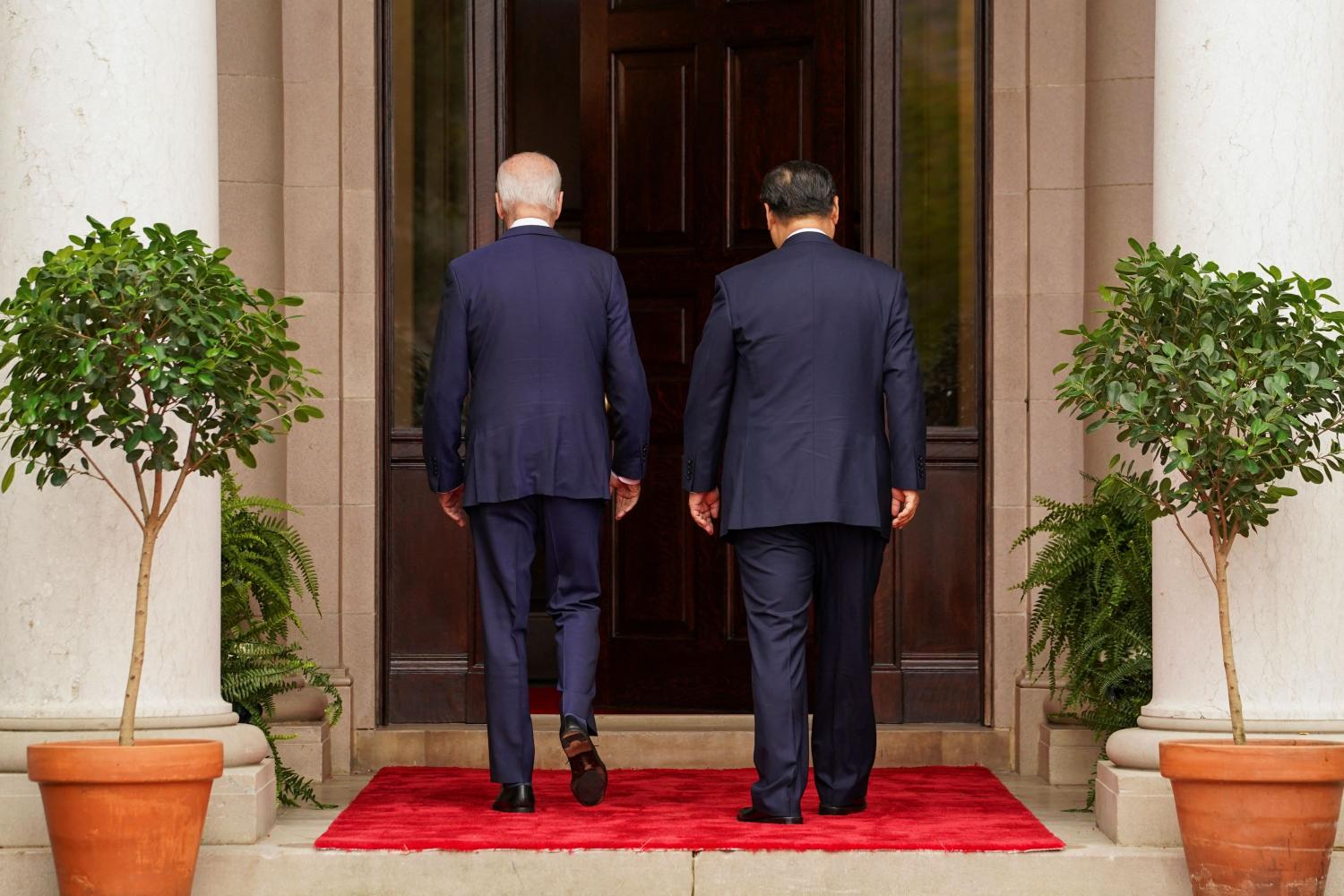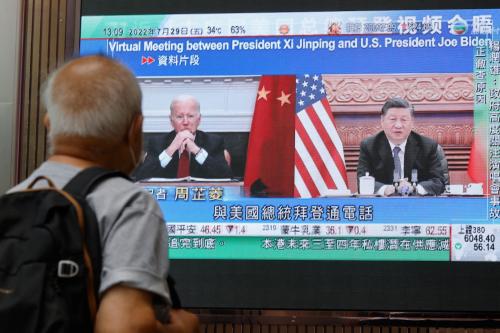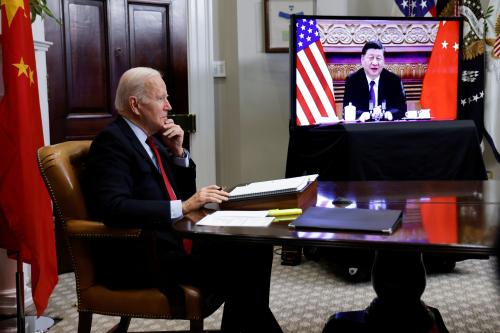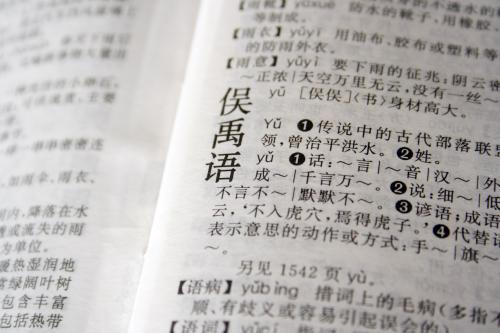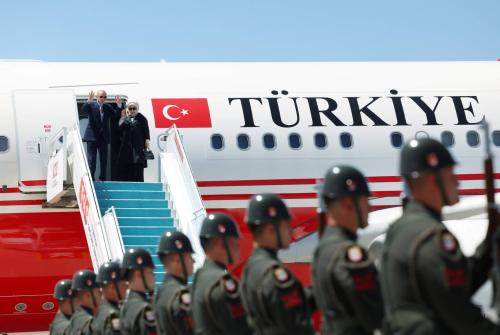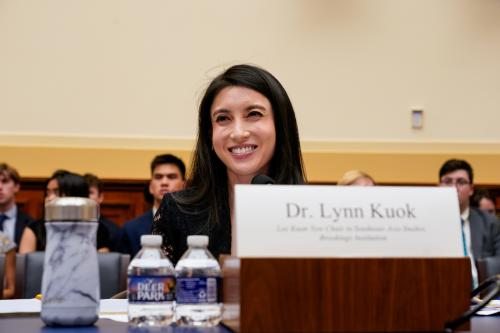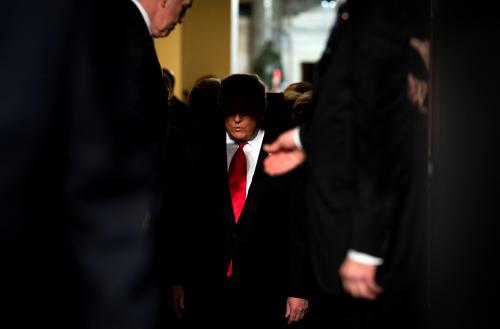Executive summary
There has been a proliferation of forecasts in recent years for when the United States and China may enter conflict. For some, these forecasting exercises have been driven by concerns about an erosion of stability in the Taiwan Strait. For others, they have been a function of a shrinking gap in national power between the United States and China. Yet others have speculated that China may be peaking in national power and may sense a fleeting moment to secure its objectives, by force if necessary, before it begins its descent.
This paper offers a different frame for evaluating the U.S.-China relationship. Based on a review of the relationship over the past 75 years, this paper argues that when both countries feel secure and optimistic about their futures, the relationship generally functions most productively. When one country is confident in its national performance but the other is not, the relationship is capable of mudding through. And when both countries simultaneously feel pessimistic about their national condition, as is the case now, the relationship is most prone to sharp downturns. Domestic factors alone do not dictate the trajectory of relations. They do, however, play a larger role in influencing the relationship than otherwise has been observed in much recent public commentary.
This model for evaluating the relationship yields several policy-relevant conclusions. It suggests the relationship is dynamic and responsive to developments in both countries, as opposed to being captive to historical forces leading immutably toward conflict. It highlights that the relationship has navigated frequent zigs and zags over the past decades and rarely travels a straight line for long. It also makes clear that there is not a market now for bold new thinking about managing the bilateral relationship. The current task for policymakers in Washington and Beijing is to navigate through the concurrent down cycles in both countries while keeping bilateral tensions below the threshold of conflict.
Situating the present moment
The U.S.-China relationship is both strained and devoid of ambition. Conversations with officials from the U.S. and Chinese governments have yielded little optimism for potential improvements in bilateral relations in the foreseeable future. Policymakers in both countries appear to be primarily concerned with limiting the risks of escalation through 2024 and developing more durable means of managing competition over the longer term.
The current state of relations comes as no surprise; the bilateral relationship has traveled a negative trajectory from 2017-2023. Tensions relaxed modestly following the Woodside Summit between President Joe Biden and President Xi Jinping in November 2023. At that summit, both leaders reaffirmed the need for the United States and China to manage competition without resorting to conflict. Biden afforded Xi public dignity and respect and reaffirmed the United States’ longstanding policy on Taiwan, and in return, Xi showed responsiveness to America’s top concerns, including by agreeing to staunch the flow of fentanyl precursors from China, restore military-to-military communications, and launch a bilateral dialogue on governance of artificial intelligence technologies and their applications. These steps were laudable, even if they were largely tactical.
As important as these efforts were by both leaders to set a floor under the relationship, they did not alter the trajectory of relations. There are deeper undercurrents influencing bilateral relations that merit further examination, namely the domestic conditions inside both countries. These undercurrents presently are pushing both countries toward intensifying rivalry.
Explanations for the downturn in relations
Both Washington and Beijing have their own explanations for why the relationship has fallen into its current trough. As Jeff Bader, Patricia Kim, and I argued in 2022, Washington believes that Beijing has grown impatient and aggressive over the past decade of Xi’s rule. By trampling the rights of its citizens at home, militarizing efforts to assert control over contested territorial claims along its periphery, actively seeking to make the world compatible with its authoritarian vision of governance, and announcing its intentions to dominate next-generation technologies, many in Washington’s policy community believe Beijing has violated universal values and exposed its revisionist ambitions.
Other American experts go further, arguing that China’s goals for global leadership are incompatible with America’s longstanding role in the world. Still others assert that America and China are destined for conflict, either because of differences over Taiwan or as a function of shifts in relative power, the so-called Thucydides trap. Prominent American politicians, such as Representative Mike Gallagher (R-Wis.), frame the contest in ideological terms, warning of the risks of America becoming “Xinjiang-lite” unless China’s global march to dominance is stopped.
China’s explanation for the downturn in relations focuses on U.S. anxiety over its relative loss of power to an ascendant China. Many Chinese analysts believe the United States is lashing out against China to seek to slow China’s rise and preserve Washington’s leadership position in the international system. According to this logic, U.S. efforts to focus attention on human rights concerns, highlight China’s domestic challenges, withhold critical technology, and isolate and contain China are driven by the strategic motive of weakening China and delegitimizing the Chinese Communist Party (CCP).
None of the popular narratives in either country capture the root causes for the intensifying competition. At their core, both countries believe their governance and economic models are best equipped to meet the 21st century’s challenges. Both believe they are natural leaders in Asia and on the world stage. Both countries are contending with rapid societal transformations, which are being exacerbated by the impacts of the fourth industrial revolution. And both countries are determined to limit vulnerabilities to the other while seeking to gain an edge in emerging technologies. This is all occurring while the United States and China remain unsatisfyingly locked into a relationship that is at once both competitive and interdependent. In other words, the United States and China are competing to demonstrate which governance, economic, and social system can deliver the best results in the 21st century.
This notion of competing governance and social systems goes a long way toward explaining the rivalrous nature of relations, but it does not explain why bilateral tensions have intensified and accelerated in recent years. To better understand this trend, one must also place the current moment in a historical context.
This paper introduces a new variable for understanding the rivalry’s rising intensity. It argues that the United States and China presently find themselves in a simultaneous cycle of insecurity and dissatisfaction with their national conditions. Like when U.S. and PRC national down cycles have coincided in the past, this simultaneity is serving as a propellant in both countries for framing the national contest for power and influence in dramatic and, to some, existential terms.
Reviewing past political cycles
For China under the CCP, anxiety about external threats—real or imagined—is a continuous feature of its governance system. Successive Chinese leaders since Mao Zedong have used external threats as rationales to rally greater unity and cohesion at home.
Mao was a master at using outside challenges to unite support behind him. In an interview in 1939, a decade before the founding of the People’s Republic of China (PRC), Mao declared, “We should support whatever the enemy opposes and oppose whatever the enemy supports.” He framed issues in zero-sum terms, fostering a political climate rife with suspicion, intrigue, and antagonism. Mao encouraged a mindset that CCP leaders must display loyalty to him and hang together lest they all hang apart.
After the founding of the PRC in 1949, Mao launched a series of campaigns to consolidate his personal control and neutralize enemies of his vision for the future of China. These included the campaign to suppress counterrevolutionaries from 1950-1953, the Great Leap Forward from 1958-1962, and the Cultural Revolution from 1966-1976. These campaigns were historic in their scale and brutality.
The Cultural Revolution was Mao’s final act. It generated societal upheaval, widespread purges, and ideological battles. Following Mao’s death in 1976, China entered a brief power struggle, culminating in Deng Xiaoping’s ascent.
Deng used Mao’s tactic of purges in his initial period as he consolidated power, but then shifted toward a more pragmatic governance path. Deng declared in 1978, “Independence does not mean shutting the door on the world, nor does self-reliance mean blind opposition to everything foreign.” In these and other gestures, Deng sought to move China away from devastating campaigns and instead introduce domestic reforms to distribute power, create orderly leadership transitions, carve out a larger role for the private sector, and allay external anxieties about China’s rise.
Deng’s tenure as leader did include cataclysms, none sharper than the Tiananmen massacre on June 4, 1989. In keeping with the CCP’s pattern of blaming outside forces for internal challenges, Beijing Mayor Chen Xitong framed the Tiananmen protests as part of a global capitalist scheme to undermine socialism in his report to the National People’s Congress. Chen alleged that Western powers and Chinese intellectuals had colluded with certain CCP members to incite “political turmoil.” (Chinese leaders recycled similar allegations several decades later to respond to widespread public protests in Hong Kong in 2014 and 2019-2020.) Paranoia infused the public explanation Deng and his leadership cohort used to justify the bloody crackdown on June 4 and their subsequent consolidation of political power.
During the period between Mao’s death in 1976 and Xi Jinping’s ascent to power in 2012, there were other crackdowns. Chinese citizens’ rights were systematically curtailed and public dissent of CCP decisions was dealt with harshly. There was widespread ethnic and religious persecution, particularly in Tibet and Xinjiang. By and large, though, China experienced unprecedented progress during this period. More Chinese people were lifted out of poverty in these decades than any country had achieved in any previous period in human history. China’s economy boomed. Optimism prevailed among a wide cross section of Chinese society.
Xi was elevated to leader in 2012. In one of his early actions as leader, Xi launched an aggressive anti-corruption campaign to target “tigers and flies,” in other words, officials at all levels engaging in illicit activities. In the decade since, Xi has used the anti-corruption campaign as a vehicle for consolidating power and enforcing loyalty. The campaign has netted over 2.3 million officials, including serving and retired leaders at the pinnacle of the CCP’s power structure.
In 2013, the CCP published an internal document titled “Communique on the Current State of the Ideological Sphere.” This declaration, often referred to as Document Number Nine, warned against the dangers of adopting Western values and systems. It singled out concepts such as constitutional democracy, civil society, and freedom of the press as elements of a strategy by the United States and other Western actors to undermine the CCP’s leadership. In doing so, Xi and his team returned to the well-worn playbook of invoking fears of external threats to demand internal unity.
Even as Chinese leaders were launching a campaign to impose vigilance against alleged American and Western attempts to topple the CCP, the U.S.-China relationship remained relatively stable during 2012-2016. There were strains over the South China Sea, cyber-espionage, Taiwan, and other issues during this period, but there also was a sense of common purpose around climate issues, public health, and nonproliferation. The U.S.-China relationship did not reach an inflection point until 2017, or perhaps 2018.
This inflection point in the relationship resembled but did not match the comprehensiveness of the break in U.S.-China relations in the early 1950s, following the founding of the People’s Republic of China. And yet the shift in 2017 or 2018 was sharper than during other periods of Chinese turmoil, such as during the Tiananmen massacre and its aftermath. This begs the question, why have U.S.-China relations suffered sharp downturns during specific periods, but not during other moments of internal turmoil in one or both countries?
Why some political cycles generate bilateral turmoil
For some, the answer is tied up in the personalities of the American leaders involved in managing U.S.-China relations during these sensitive moments. In this telling, President George H.W. Bush and his deputies were overly solicitous of stable relations with the Chinese, and this orientation caused them to “let China’s leaders off the hook” for massacring protesting students near Tiananmen Square. Similarly, Presidents Bill Clinton, George W. Bush, and Barack Obama were naïve in hoping that China’s deepening integration into the global economy would create pressure for political change inside China.
While American leaders’ views—and their connections with their Chinese counterparts—certainly factor into how the relationship is managed, they alone do not provide explanatory value for why the relationship weathered certain shocks but not others. Rather, by analyzing upturns and downturns in U.S.-China relations over the past 80 years, the U.S.-China relationship appears most prone to sharp volatility when both countries simultaneously are experiencing cycles of insecurity and pessimism about their futures. When only one of the two parties enters a cycle of national instability, the relationship generally can weather turbulence without experiencing sharp deterioration in relations. The moments of non-linearity in the trajectory of relations occur when both countries simultaneously enter domestic political down cycles.
The two periods in the last 80 years when the United States and China simultaneously were in such down cycles were the early 1950s and the period since 2016. In the early 1950s, Mao was launching consecutive campaigns to keep his adversaries off-balance while he sought to consolidate power. Inside the United States, Senator Joseph McCarthy was advancing a paralyzing campaign to root out communist sympathizers in government and society. McCarthy warned that communists had infiltrated the government to launch “a conspiracy on a scale so immense as to dwarf any previous such venture in the history of man.” McCarthy vowed to tear apart government and society until every communist was rooted out.
McCarthy symbolized a sense of malaise that had pervaded the United States in the wake of World War II. Even though the United States had triumphed in the war, it struggled to gain confidence that it would win the peace. The Soviets appeared on the march in Europe, Asia, and the Middle East, and Americans were fearful of their inability to halt Moscow’s advances.
Thus, both the United States and China found themselves simultaneously in a period of intense domestic turmoil in the early postwar years. This turmoil was exacerbated by ideological divisions between both countries as the Cold War’s battle lines began to take shape. These forces placed strong downward pressure on a relationship that had not yet taken root following the CCP’s establishment of the People’s Republic of China in 1949. The result was a period of prolonged enmity and estrangement.
Both countries would remain sealed off from each other until Henry Kissinger’s groundbreaking visit in 1971. Even though China was convulsed by the Cultural Revolution and the United States was consumed by war in Vietnam at that time, leaders in both countries saw beyond their immediate domestic challenges. President Richard Nixon, Mao, Kissinger, and Premier Zhou Enlai realized their respective geostrategic positions vis-à-vis the Soviet Union would be advanced by coming together. Balance-of-power politics compelled the leaders to seize that strategic opportunity, even amid domestic turmoil. Nixon’s and Mao’s decision to seize the strategic initiative in that moment of simultaneous U.S. and Chinese down cycles served as the exception to the pattern that this piece highlights.
One of China’s next major domestic convulsions occurred in 1989 with the Tiananmen protests and subsequent massacre. These events occurred at the twilight of the Cold War. Even though it was not yet apparent at the time that the Berlin Wall would fall several months later, there nevertheless was a sense of optimism inside the United States that America was ascendant on the world stage. Many American commentators saw Japan’s economic ascent as America’s primary challenge. By and large, America saw itself as strong and strengthening, with a relatively calm domestic environment, while China was experiencing a societal shock. However, over the next decade, China experienced rapid economic growth and modernization, leading to China’s emergence as a global economic powerhouse and, for the most part, domestic stability.
America experienced its own shock on September 11, 2001. That day’s terrorist attacks triggered anxieties inside the United States that manifested in a dramatic expansion of domestic security, an increase in anti-Muslim racism, and the launching of two grinding wars in Afghanistan and Iraq. China at that time was largely stable and confident in its national trajectory. China’s president, Jiang Zemin, was among the first world leaders to reach out to President George W. Bush to offer condolences and support, saying that “the attacks have not only brought about a disaster to the American people, but also a challenge to the sincere desire for peace of the world people.”
America suffered another shock in 2008-09 with the global financial crisis. The crisis, which emanated from America’s financial and housing sectors, shook the American economy and depleted millions of Americans’ lifetime savings. American leaders reached out to their Chinese counterparts to propose that both countries coordinate to control the financial contagion. Chinese leaders saw such an approach as serving their own interests. They acted on America’s invitation to co-lead the global economic recovery. Beijing’s response highlighted China’s growing economic strength and confidence in its national capacity to lead on the world stage.
Xi’s ascent to power in 2012 and his subsequent launch of a national anti-corruption campaign coincided with Obama’s second term in office. Obama’s political image was forged by optimism about the future. He presented himself as a leader who would pull the United States out of the global financial crisis and propel the country forward, focusing on creating a more just and equitable union at home and bolstering American leadership abroad. He saw China as a formidable competitor that would play a growing role on the world stage in the 21st century. He did not view China as an existential threat to America and its way of life.
Donald Trump ushered in a major shift. He warned Americans that China was “raping” the United States by stealing jobs, and framed the competition between the United States and China as “the Chinese Communist Party … versus freedom-loving people everywhere.” At the same time, Trump also occasionally lavished praise upon Xi as a “strong leader” who could unite 1.4 billion people behind his vision for the future of China.
Although Trump’s rhetoric and posture on China vacillated considerably, the important point is that his term in office marked a return for America to one of its recurring cycles of self-doubt and outrage over injustices, real and perceived. Trump helped frame domestic disputes not as negotiable interests that could be reconciled through America’s political process, but rather as social conflicts that involve deeper values, fears, and hatreds. His tirades against China were an element of these efforts. Trump tapped into a sense of anger many Americans felt—about lost jobs, fading prospects for advancement, and failure to deliver a brighter future for the next generation. He urged his followers to use him as their vehicle for reclaiming power and control in America.
Biden has adopted a starkly different approach toward governance than his predecessor. He has returned America to its constitutional tenets and its normal political rhythms. Even so, political polarization in America remains sharp. For many in the country, political differences are not subject to resolution through compromise but instead are seen as a moral contest between light and darkness. And despite steady economic growth, about three-quarters of Americans at the end of 2023 believe the country is headed in the wrong direction. A majority of Americans believe their country is in decline. There is diminishing consensus inside America on what role it should play in the world, or whether America should pursue leadership on the world stage at all. Arguments in favor of greater nationalism and protectionism appear to be gaining purchase in national debates.
That the U.S.-China rivalry has continued to intensify throughout the Trump and Biden administrations supports the argument that factors beyond the personalities and preferences of individual leaders inform the trajectory of U.S.-China relations. Trump and Biden are different in many respects. One throughline of both of their presidencies, though, has been a sense of pessimism and loss of control among large portions of the American electorate about their country’s future.
As Richard Hofstadter demonstrated in his seminal essay, “The Paranoid Style in American Politics,” America is prone to cyclical bouts of pessimism and fear that its way of life will be destroyed by outside forces. Previous periods of American anxiety about foreign interference have included widespread fears of the Illuminati in the late 1790s, the Freemasons in the 1820s, Catholics and European monarchs in the 1830s-1860s, and communists in the 1950s. Americans also have shown a stubborn pattern of anxiety about national decline. Previous bouts have included those occurring during Soviet expansionism in the early period of the Cold War; after Sputnik in 1957, the OPEC oil embargo in 1973, and the U.S. defeat in Vietnam in 1975; and in response to Japan’s economic surge in the 1980s.
While the scapegoats of this current bout of national anxiety are varied and include globalists, immigrants, and allies, China serves as an organizing feature of discourse. China and its leaders act as a foil that certain American leaders use to warn against the erosion of national character and the depletion of national competitiveness.
Meanwhile, China is navigating its own simultaneous period of malaise. Youth unemployment is north of 20 percent. Record numbers of Chinese citizens are leaving the country in search of freedom and opportunity abroad. China’s demographic profile is worsening. China’s housing market is in the doldrums and its stock market has lost over $6 trillion in market capitalization since its peak in 2021. Some of China’s most visible leaders, such as its defense and foreign minister, are disappearing without notice or explanation. While there are pockets of technological advancement in areas such as electric vehicles, renewable energy technologies, and batteries, China’s overall economy is slowing and showing signs of diminishing dynamism.
To be fair, China’s current problems appear most pronounced when compared to its own past performance. The country is decelerating from annual economic growth of 7.7 percent in the decade prior to COVID-19 to forecasted growth of 3-4 percent for the remainder of this decade. On a relative basis, much of the world continues to envy China’s current growth rates. China also could make policy adjustments to boost growth. Even so, given Xi’s concentration of power, his abolishment of term limits, Beijing’s emphasis on state security, and its focus on building a state-directed economic growth model, there appears to be declining optimism in China that any policy course correction is on the horizon.
In other words, the United States and China are both dealing with significant, albeit different, domestic challenges at this current moment. America is undergoing a national self-examination of its internal character and its role in the world, while China is facing rising repression and slowing economic growth. Even so, the broader point is that when national pessimism coincides in both China and the United States, the confluence can serve as an accelerant of U.S.-China confrontation and an intensifier of rivalry. This current moment offers fresh evidence for such an observation.
Implications
This examination of how simultaneous bouts of insecurity and pessimism in the United States and China are impacting their bilateral relationship is intended more as a thought experiment than an empirical study. However, if this thought experiment holds explanatory power, it would lead to several implications for evaluating U.S.-China relations.
First, this thesis would lend credence to a mental framework that successive generations of American policymakers have passed down from the 1970s to the present: the relationship functions best when Washington and Beijing both feel secure and optimistic about the future, and the relationship is most turbulent when both countries feel insecure and pessimistic. This study would fill in several gaps between those two poles. For example, this survey reveals that both countries are capable of muddling through when only one of the two parties is navigating turbulence, such as was the case around the Tiananmen massacre, September 11, the global financial crisis, and the period from 2012-2016. Also, the two countries can overcome the effects of simultaneous down cycles when they both have leaders who are determined to focus on the strategic horizon instead of the immediate moment, such as was shown between Nixon and Mao in 1972.
Second, this thesis would support viewing the bilateral relationship as dynamic and responsive to developments in both countries, and not hostage to immutable historic forces or a function of their leaders’ personalities and preferences. In other words, the United States and China are not predestined to conflict based on past patterns between rising and established powers. The nature of bilateral relations also is not simply an extension of two leaders’ preferences and personalities. There are other factors involved, specifically both countries’ internal dynamics and their levels of confidence in their national directions.
Third, these findings would suggest that during periods of simultaneous tumult in both countries, which appears to be the case now, the focus for both should be on getting their own houses in order. At this current moment, there is no market for bold creativity about reimagining the bilateral relationship. Rather, the demand signal from both capitals is for sober thinking about guarding against downside risks and seizing limited opportunities for mutually self-interested coordination on common challenges, such as climate change, public health, and risk reduction in the employment of new and emerging technologies in national security.
Even as the current moment is not conducive to exuberant optimism, neither should it be susceptible to excessive fatalism. This survey of the relationship’s recent history highlights how the relationship rarely travels on a straight line for long. A cursory review of the past 75 years of U.S.-China relations reveals various zigs and zags, from the early years of enmity and estrangement following the PRC’s founding to the cautious opening between Nixon and Mao in 1972, to the guarded optimism surrounding the opening of diplomatic relations and then America’s deep disappointment following the Tiananmen massacre, to the shared project of integrating China into the global economy, followed by joint work to combat climate change, and finally to the current period of sharp and intensifying rivalry.
If past is prologue, there will be periods in the relationship when patience is needed while one or both countries work their way out of domestic down cycles. And then there are periods when both countries simultaneously feel secure and optimistic about their futures. These are the periods when there is openness to bold ideas for advancing bilateral relations, even amid irreconcilable differences over fundamental issues such as Taiwan, human rights, and the distribution of power in the international system. If this is the case, then the project for the moment is to manage through the current down cycle in relations while preparing for a future moment when there is more space for new thinking about the relationship.
These findings will feel unsatisfactory to many observers of the U.S.-China relationship in both countries. For example, Chinese nationalists will balk at the suggestion that factors beyond U.S. hostility to China’s rise are informing the current downturn in relations. Biden’s supporters will chafe at any assertion that Americans currently lack optimism in their country’s future. Human rights advocates and democracy promoters will argue that this framing insufficiently weighs ideological differences and the impacts of China’s rising repression at home and its efforts to export elements of its security practices abroad. National security experts will critique this model for underemphasizing the degree to which China’s aggressive actions in the South China Sea, the Taiwan Strait, and along the Sino-Indian border have intensified the U.S.-China rivalry. Others will argue that external factors should be accorded greater consideration in any assessment of the U.S.-China relationship. In other words, the U.S.-China relationship does not operate in a vacuum and cannot be understood only by looking at factors within both countries.
I am sympathetic to many of these critiques. The purpose of this paper is not to elide these factors or minimize the fact that China has contributed disproportionately to the downturn in relations. Rather, it is to highlight the impact of domestic political cycles in the United States and China on the management of the bilateral relationship.
Several facts about the relationship are inescapable. The U.S.-China relationship is the most complex bilateral relationship in the world. It will have the greatest impact on the largest number of people in the world. U.S.-China competition is a structural feature of the international system. It is a relationship that defies single-factor explanations, including in this study.
Nevertheless, by focusing on the role of U.S. and Chinese domestic cycles on the relationship between both countries, this piece aims to illuminate a variable in the relationship that has been relatively under-explored amid recent enthusiasm around great power competition, ideological struggle for supremacy, and forecasting future conflict. There are exceptions, such as Evan Medeiros’s recent examination of the role of domestic politics on the relationship. This piece seeks to add to that inventory, helping to broaden understanding of how political cycles in both countries will influence the trajectory of relations between the world’s two largest powers in the 21st century.
-
Acknowledgements and disclosures
The author would like to thank former senior research assistant Mallie Prytherch for her research support for this piece as well as Adam Lammon for editing and Rachel Slattery for layout.
The Brookings Institution is committed to quality, independence, and impact.
We are supported by a diverse array of funders. In line with our values and policies, each Brookings publication represents the sole views of its author(s).

